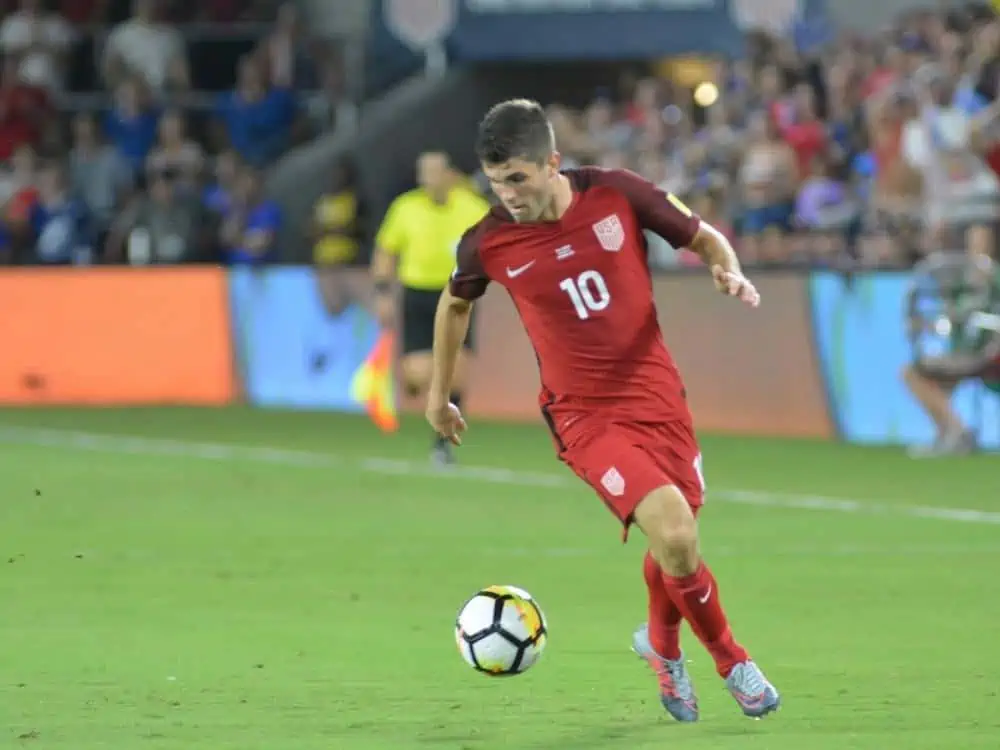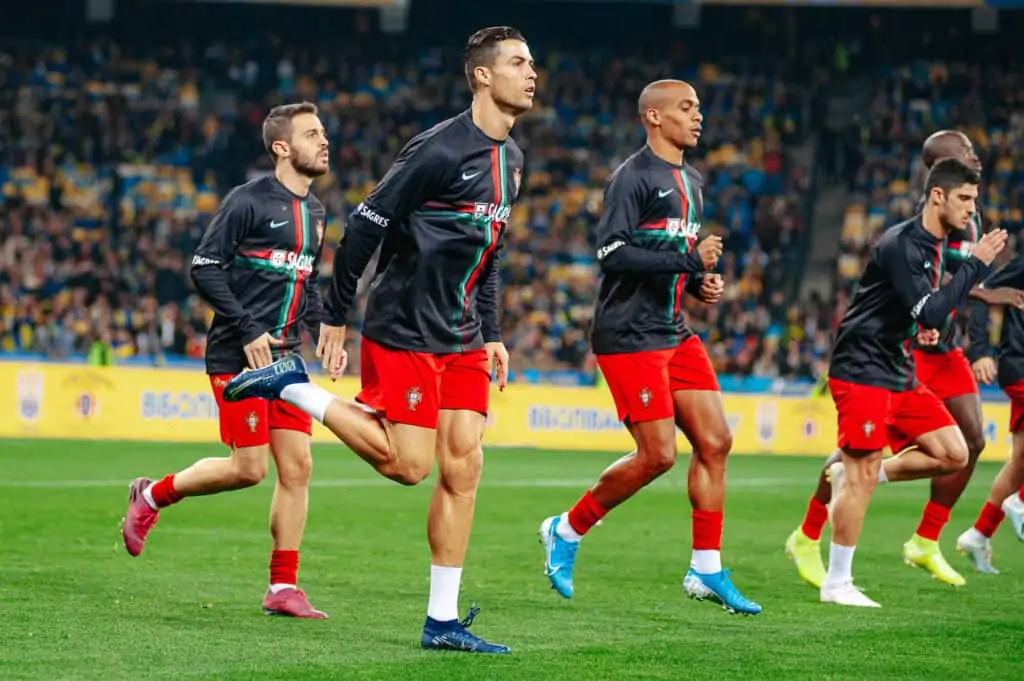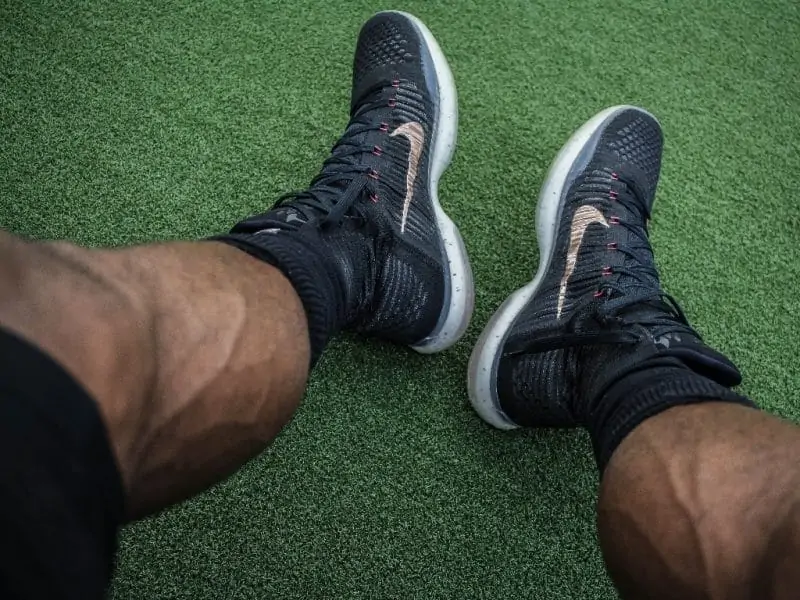Share the post "Why Do Soccer Players Have Big Leg Muscles? (Here’s What to Do)"
At a professional level, soccer players need big leg muscles for high stamina levels to compete as world-class athletes.
They’re competing up to 3 or 4 times per week for 90-minute games.
Players are constantly on the move with many short sprints, jogging, and jumping. Soccer players need to be lean, flexible, agile and have a very strong core and big leg muscles.

Why do soccer players have big leg muscles?
Soccer players need big leg muscles for strength, power, and stamina that’s required for intense competitions. Whilst staying injury-free.
Soccer players are constantly on their feet, with the main actions being running, kicking, jumping, and turning.
Defensively, the legs are the most important tools.
They’re used to block, tackle, and slide. They’re also put under constant strain from impact/physical contact.
The main muscles used and worked on are:
- Calves
- Quads
- Hamstrings
A player must focus training on building their leg muscles for:
- Speed
- Acceleration/Deceleration
- Power
- Jumping
- Flexibility
- Endurance
One of the most important traits a soccer player must have is strong, muscular legs, capable of meeting the demands of a full season of training and matches.
Soccer is played predominantly using the legs.

These muscles serve different functions, some of which may or may not be for vanity reasons.
Let’s take a more detailed look at the role the legs play for a soccer player, what each muscle group actually does, and how players train and work out their legs.
Why do soccer players have big legs?
The main roles of the legs in soccer are for running, speed, acceleration, power, jumping, flexibility, and endurance. Let’s take a further look…
Running
Soccer players run an average of 7 miles in a game, with certain positions covering closer to 10 miles per contest. That’s a lot of running, especially when we compare to other sports:
| Sport | Avg. distance run per game (miles) |
| Baseball | 0.0375 |
| American Football | 1.25 |
| Basketball | 2.55 |
| Tennis | 3 |
| Field Hockey | 5.6 |
| Soccer | 7 |
Speed
Speed can be a tricky ability to study. It’s quite a general measurement when there’s no in-game application. A player may be dribbling a ball while sprinting, or changing direction.
A soccer player will rarely sprint further than 20 meters at a time, meaning that +4 second sprints aren’t often observed.
Therefore the maximal speed of a player isn’t necessarily a relevant statistic. In any case, leg muscles are a core component of speed.
- Real Madrid and Wales National team player, Gareth Bale, holds the record for the highest speed recorded on a soccer field, where he topped out at 39.9 km/h (24.79 mph). To give this some context,
Usain Bolt’s max speed ever recorded was 44.72 km/h (27.8 mph).
Considering that Bolt is the fastest man to ever live, and Bale was recorded hitting that speed in-game, running on a field, in cleats, the speed is truly staggering.
Acceleration
As alluded to above, it’s beneficial for a player to work on their speed over short distances to make significant impacts on their overall game.
The ability to decelerate is also crucial. Players need to be able to slow down, stop, or change direction at a moment’s notice.
Control in such instances is critical. Fast-twitch fibers in the leg muscles are responsible for the explosive movements carried out in soccer, particularly accelerating and decelerating.
Power
Leg power is necessary for many on and off the ball techniques and movements, such as:
- Kicking (shooting, passing, etc.)
- Vertical jump.
- Short sprints / acceleration / deceleration.
- Functional strength and balance.
Jumping
A player’s jumping ability is important for individual and team performance. Many instances throughout a game will require a player to jump, both defensively and offensively.
Strong and powerful leg extensors are needed to ensure adequate performance in these scenarios.
Flexibility
Leg flexibility can be the difference between a player reaching across at the back post to score a crucial goal or missing it.
It can be the reason a player makes a successful last-ditch tackle to prevent an opponent from scoring, or it can simply come in handy when controlling an awkward pass.
Although great flexibility isn’t a necessity to be a quality player, it can be an absolute game-changer.
Modern players dedicate a huge amount of time to help limber up their bodies and to become more flexible.
Zlatan Ibrahimovic has displayed countless examples of game-changing flexibility throughout his career.
Here is one spectacular example, showing his amazing leg dexterity at the tender age of 37.
Endurance
Between games, practices, and other sport-based activities, soccer players absorb a high volume of impact and collisions on their legs.
They must be trained, treated, and rested adequately to be able to endure this and prevent serious injury.
Soccer Player’s Calves
The calf muscles are located on the back of the lower part of the leg. Soccer player’s calves are constantly engaged in a match or training session, from running, jumping, and particularly during explosive movements (acceleration, deceleration, and kicking).
Does playing soccer make your calves bigger?
Soccer players generally have large, well-developed calves. By playing more soccer games and sessions, your calves will adapt and grow bigger.

Soccer Player’s Quads
The quadriceps are a four muscle group located on the front of the thigh. They link directly to the knee joints and muscles.
Quads are crucial in running, jumping, and kicking.
They’re the main contributors to generating power in kicking. Soccer players tend to have large, lean, well-developed, and often fibrous-looking quad muscles.
Soccer Player’s Hamstrings
Hamstrings are a set of three posterior thigh muscles. Located at the back of the thigh, they cross both the hip and knee joints.
Soccer players’ hamstrings undergo a lot of stress as they’re the main component in thrusting players forward.
As players are required to perform several short sprints during games, they’re subject to a lot of force.
- Subsequently, hamstring injuries are very common. Around 40% of injuries in soccer are to hamstrings.
Anatomically speaking, humans are built for jogging and endurance rather than intense, explosive sprinting.
This could also be one of the main factors behind hamstring injuries.
How do soccer players build leg muscle?
Running
Running is part of all soccer training sessions and matches. Jogging, sprinting, changing directions, jumping.
Plus, other running movements help strengthen, lean out, and increase the endurance of the legs.
Strength and Conditioning
Strength and conditioning have become an important part of a modern pro soccer player’s training schedule.
Each player will usually have a personalized program and will do gym work at least 2 to 3 days per week. As you can imagine, the legs are concentrated heavily.
- It would be common for players to perform a leg-based gym circuit twice per week, however, Scott Miller (coach at Fulham FC) recommends that they leave 2 rest days before a game to ensure they’re able to recover.
In the regular season, players often avoid lifting heavy weights to lower the risk of injury.
The main muscles targeted are calves, quads, hamstrings, glutes, and adductors.
Here are some common leg exercises a player may perform:
- Squats
- Walking Lunges
- Dumbell Squats
- Box jumps
- Reverse Lunges
- Glute bridges
These exercises focus on building strength, as well as improving speed and power.
How to recovery after working out your leg muscles?
Recovery is essential for any elite athlete. It keeps their bodies fit, strong, and it’s one of the main combatants of injury.
Recovery is an essential part of building muscles. The muscles tear after a workout and need rebuilding.
Players go above and beyond to ensure that they recover their legs after training and games.
The top players get massages after every workout, with this cool massage gun on Amazon you can treat yourself. Here are some of the other best methods:
Leg Warm Downs
Performed immediately after a game or at the end of a training session. Light cardio helps rid the body of lactic acid and other waste that builds during exercise.
These allow the body to recover much faster.
Sleep and Rest
Sleep is the best and most natural form of recovery. It’s important that pro’s in today’s game monitor their sleep very closely.
Some of the major teams around the world have sleep pods at their training grounds in case a player needs to get some rest.
Foam Roll
These are often used in active recovery sessions to work out muscle knots. The foam is used as a massage for players, it helps with aches and pains.
Watch this video for a great demonstration;
Cold Water Immersion (E.g. Ice baths)
Behind sleep, ice baths are often regarded as the best type of muscle recovery for athletes.
- Coldwater immersion reduces inflammation and soreness, restores muscle contractile function and it forces production.
It also maintains athletic performance over a sustained period of activity, and aids faster recovery.
Mobility Work
Active recovery is performed by all soccer players. It reduces tightness in the muscles and helps improve and stabilize the muscles and joints.
It plays a crucial role in injury prevention
Hydration
Drinking water replaces the vital mineral and electrolyte stores that are lost due to sweat.
Refueling
Players must be fuelled by the right foods. After a game, it’s crucial to replenish the body with high-quality foods. Protein is vital to repair and recover muscles.
As mentioned, players’ legs undergo severe stress and force throughout a game, so protein shakes or protein-rich foods are usually consumed very soon after a game/training session.
Specialist Sport
The demands of a soccer player, and in particular, their legs, require lots of training, work, and recovery. Why do soccer players have big leg muscles?
They build muscle in their legs for strength, power, and endurance so that they can play the game at the highest level while trying to stay injury-free.
The nature of the game of soccer means that a player will naturally develop quite muscular, lean legs if they’re playing a lot.
So, do you want to get big leg muscles? There more you play, the bigger your leg muscles will be.
Soccer leg muscles Q and A
Are soccer players strong?
Soccer players, on average, are not very large athletes. Some positions require a bigger, stronger player (a center-back or goalkeeper for example).
However, they have exceptional balance, a low center of gravity, and strong core strength. They’re lean and slim, yet functionally strong for their size.
Do soccer players lift weights?
Not all players do, but most incorporate weight training into their workout routines, particularly in the offseason.
Can a soccer player be too muscular?
Functional and optimal strength is key for soccer. They require a high level of endurance and stamina.
If a player carries a large amount of excess muscle, they’re likely to be slower and to tire easier. Therefore, soccer players tend to not be overly muscular.
Share the post "Why Do Soccer Players Have Big Leg Muscles? (Here’s What to Do)"
Joel is a seasoned soccer journalist and analyst with many years of experience in the field. Joel specializes in game analysis, player profiles, transfer news, and has a keen eye for the tactical nuances of the game. He played at various levels in the game and coached teams - he is happy to share his insight with you.



